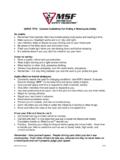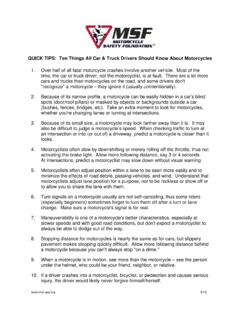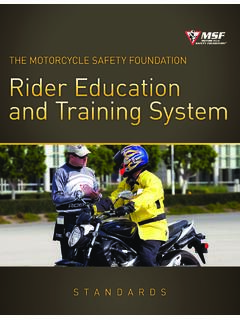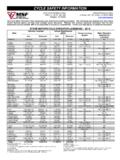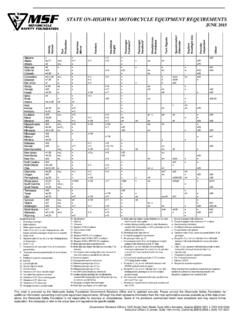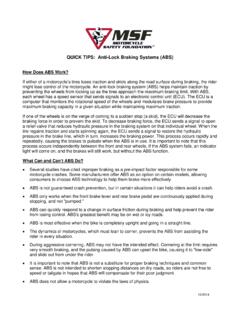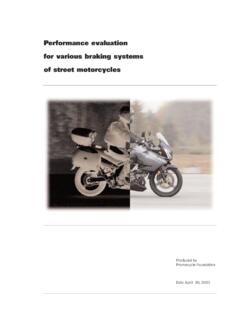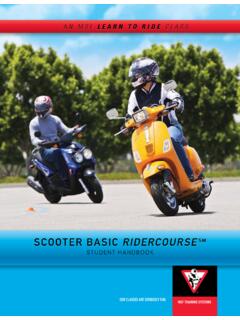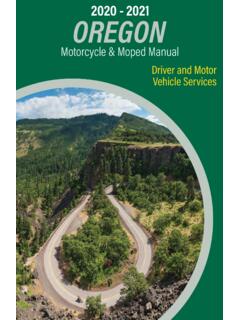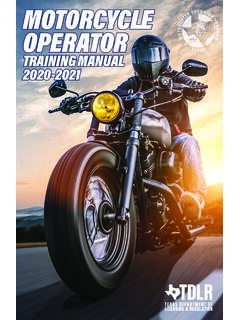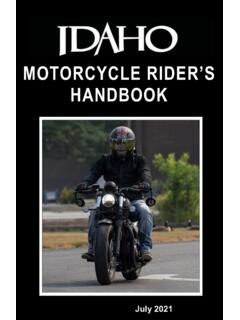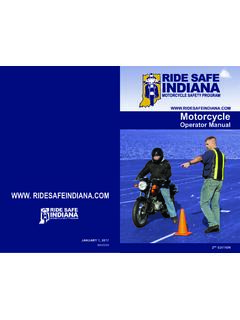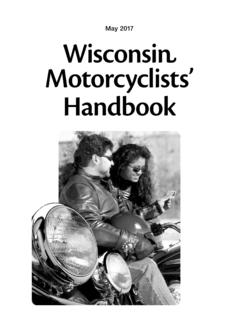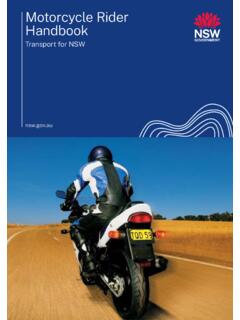Transcription of Motorcycle operator Manual - Motorcycle Safety Foundation
1 MotorcycleoperatorManualMSF LICENSING PROGRAMSan msf manualWith Supplementary Information for Three-Wheel Motorcycles16th Edition2 PrefaceWelcome to the Sixteenth Edition of the MSF Motorcycle operator Manual (MOM). Operating a Motorcycle safely in traffic requires special skills and knowledge. The Motorcycle Safety Foundation (MSF) has made this Manual available to help novice motorcyclists reduce their risk of having a crash. The Manual conveys essential safe riding information and has been designed for use in licensing programs. While designed for the novice, all motorcyclists can benefit from the information this Manual original Motorcycle operator Manual was developed by the National Public Services Research Institute (NPSRI) under contract to the National Highway Traffic Safety Administration (NHTSA) and within the terms of a cooperative agreement between NHTSA and the MSF.
2 The Manual and related tests were used in a multi-year study of improved Motorcycle operator licensing procedures, conducted by the California Department of Motor Vehicles under contract to purpose of this Manual is to educate riders and to help them avoid crashes while safely operating either a standard two-wheel Motorcycle or a three-wheel Motorcycle . This latest edition has undergone significant improvements, and contains new, more in-depth information, designed to: Guide riders in preparing to ride safely Develop effective street strategies Give riders more comprehensive understanding of safe group riding practices Describe in detail best practices for carrying passengers and cargoIn promoting improved licensing programs, the MSF works closely with state licensing agencies.
3 The Foundation has helped more than half the states in the nation adopt the Motorcycle operator Manual for use in their licensing licensing, along with high quality Motorcycle rider education and increased public awareness, has the potential to reduce crashes. Staff at the Foundation are available to assist state, private and governmental agencies in efforts to improve Motorcycle Buche President, Motorcycle Safety Foundation2 Jenner, Suite 150 Irvine, CA 92618-3806 3contents THE RIDER AND THE Motorcycle 4 PREPARING TO RIDEWear the Right Gear 5 Know Your Motorcycle 7 Know Your Responsibilities 10 RIDE WITHIN YOUR ABILITIESB asic Vehicle Control 11 Keeping Your Distance 15 SEE 20 Intersections 21 Increasing Conspicuity 24 Crash Avoidance 27 Handling Dangerous Surfaces 30 Mechanical Problems 33 Animals
4 34 Flying Objects 35 Getting Off the Road 35 Carrying Passengers and Cargo 35 Group Riding 38 BEING IN SHAPE TO RIDEWhy This Information Is Important 42 Alcohol and Other Drugs in Motorcycle Operation 42 Alcohol in the Body 42 Alcohol and the Law 44 Minimize the Risks 44 Step in to Protect Friends 45 Fatigue 45 EARNING YOUR LICENSE 46 THREE-WHEEL SUPPLEMENTS upplementary Information for Three-Wheel motorcycles 48 Know Your Vehicle 48 Basic Vehicle Control 50 Carrying Passengers and Cargo 53 HAND SIGNALS 55T-CLOCS PRE-RIDE CHECKLIST 574 the rider and the MotorcycleMotorcycling is a unique experience.
5 Compared to a car, you don t sit in a Motorcycle , you become part of it. Not as a passive driver, but as an active rider arcing into a string of smooth corners, playing along with the rhythm of the road; shifting, accelerating, and braking with precision. Whether you ride to and from work or prefer the camaraderie of a group ride on the weekend, motorcycling engages all your senses and creates an invigorating sense of freedom. Along with that freedom comes responsibility. All states require some form of license endorsement demonstrating you possess a minimum level of skill and knowledge. This booklet and other Motorcycle publications can help prepare you to be successful. You might also consider taking a formal hands-on training course, even if your state doesn t require that you complete one.
6 You ll learn how to improve your riding skills and mental strategies, so you can be a safer, more alert rider. The diagram above illustrates the complex environment that awaits you, and supports the concept that, as the Motorcycle Safety Foundation says, Safe riding is as much a skill of the eyes and mind as it is of the hands and feet. Successfully piloting a Motorcycle is a much more involved task than driving a car. Motorcycling requires a fine sense of balance and a heightened sense of awareness and position amidst other roadway users. A Motorcycle responds more quickly to rider inputs than a car, but is also more sensitive to outside forces, like irregular road surfaces or crosswinds. A Motorcycle is also less visible than a car due to its narrower profile, and offers far less protection by exposing its rider to other traffic and the elements.
7 All these risks can be managed through study, training, and environMentPreParing to ride 5 What you do before you start a trip goes a long way toward determining whether or not you ll get where you want to go safely. Before taking off on any trip, a safe rider makes a point to: 1 Wear the right gear 2 Become familiar with the Motorcycle 3 Check the Motorcycle equipment 4 Be a responsible rider Wear the right gearWhen you ride, your gear is right if it protects you. In any crash, you have a far better chance of avoiding serious injury if you wear: A DOT compliant helmet Face or eye protection Protective clothing Helmet UseCrashes can occur particularly among untrained, beginning riders . And one out of every five Motorcycle crashes results in head or neck injuries.
8 Head injuries are just as severe as neck injuries and far more common. Crash analyses show that head and neck injuries account for a majority of serious and fatal injuries to motorcyclists. Research also shows that, with few exceptions, head and neck injuries are reduced by properly wearing a quality riders don t wear helmets because they think helmets will limit their view to the sides. Others wear helmets only on long trips or when riding at high speeds. But, here are some facts to consider: A DOT-compliant helmet lets you see as far to the sides as necessary. A study of more than 900 Motorcycle crashes, where 40% of the riders wore helmets, did not find even one case in which a helmet kept a rider from spotting danger. Most crashes happen on short trips (less than five miles long), just a few minutes after starting out.
9 Most riders are riding slower than 30 mph when a crash occurs. At these speeds, helmets can cut both the number and the severity of head injuries by half. No matter what the speed, helmeted riders are three times more likely to survive head injuries than those not wearing helmets at the time of the crash. The single most important thing you can do to improve your chances of surviving a crash is to wear a securely-fastened, quality SelectionThere are two primary types of helmets, providing two different levels of coverage: three-quarter and full style you choose, you can get the most protection by making sure that the helmet: Is designed to meet U S Department of Transportation (DOT) and state standards. Helmets with a label from the Snell Memorial Foundation also give you an assurance of quality.
10 Fits snugly, all the way around. Has no obvious defects such as cracks, loose padding or frayed PreParing to rideWhatever helmet you decide on, keep it securely fastened on your head when you ride. Otherwise, if you are involved in a crash, it s likely to fly off your head before it gets a chance to protect and Face ProtectionA plastic shatter-resistant faceshield can help protect your whole face in a crash. It also protects you from wind, dust, dirt, rain, insects and pebbles thrown up from cars ahead. These problems are distracting and can be painful. If you have to deal with them, you can t devote your full attention to the protect your eyes, though they won t protect the rest of your face like a faceshield does. A windshield is not a substitute for a faceshield or goggles.
